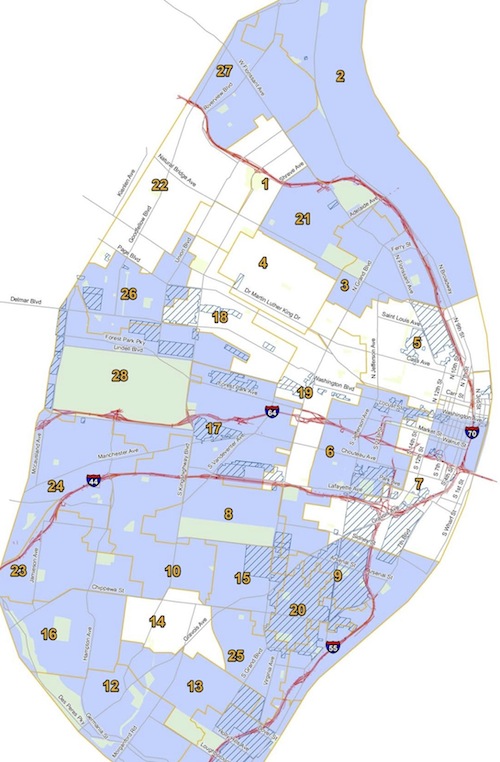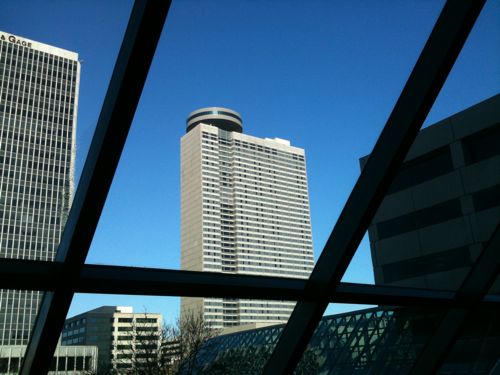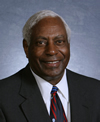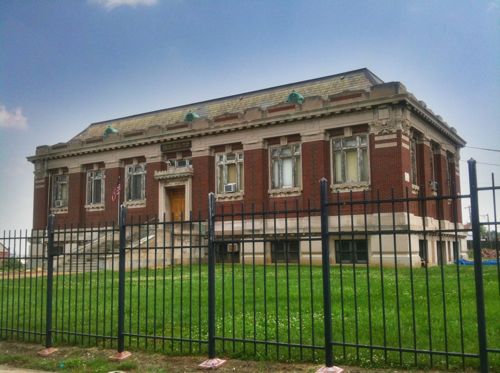Poll: Should Preservation Review be Citywide or Continue Ward-by-Ward?
|
|
The city of St. Louis is divided into 28 wards and each alderman has authority over his/her ward, the city as a whole be damned.

As the above map show, eight of the twenty-eight wards are excluded from the city’s other  Preservation Review Districts:
Any demolition application in a Preservation Review District will be referred by the Building Division to the Cultural Resources Office for review. No demolition permit may be issued without the approval of the Office.
Criteria for Review:
The Office will consider these criteria in making its determination:
- redevelopment plans passed by ordinance;
- the building’s architectural quality;
- its structural condition;
- the demolition’s effect on its neighborhood;
- the building’s potential for reuse;
- urban design factors;
- any proposed subsequent construction;
- any commonly-controlled property.
So in 30% of the city buildings can be razed without any review by the staff hired to protect our cultural history. There are some exceptions, such as the 7th ward. It appears the CBD does have preservation review and other parts of the ward would be reviewed as part of of a National Register historic district. The same thing occurs in parts of the other seven non-review wards. Forget Team Four, lack of preservation review in six north side wards has done great damage.
But ward boundaries change this year due to redistricting. Preservation Review districts don’t automatically change, these must also be changed with new legislation. Â That is, unless it was simplified and covered the entire city. Here is an example of the description of one of twenty districts:
PRESERVATION REVIEW DISTRICT THIRTEEN
Beginning at the intersection of the centerlines of Kingshighwayand Lindell, and proceeding in a generally clockwise direction east along the centerlines to Taylor, north to Maryland, east to Boyle, south to West Pine, east to Sarah, south to Laclede, east to Spring, south to Market, east to Grand, north to the Forest Park Parkway, east to Compton, south to Chouteau, west to Grand, south to Park, west to 39th, south to Blaine, west to Tower Grove, south to Interstate 44, west to Kingshighway, north to the St. Louis & San Francisco Railway tracks, west to Hampton, north to Manchester, west to Graham, north to Oakland, east to the southern prolongation of Euclid, north to Barnes Hospital Plaza, west to Kingshighway, and north to the point of beginning. (source)
Think of all the staff time to write new legislation, to alter the city’s property database.

My loft will go from being in the 6th ward to the 5th ward, from preservation review to non-review. The buildings above, in the block to the west of me, Â will also go from 6th to 5th, will suddenly be at greater risk of being razed without public input once the preservation review districts are revised. The substation is on Landmark’s 2010 Most Endangered List.

All this is to introduce the poll question for this week:Â Should Preservation Review be Citywide or Continue Ward-by-Ward? Â The poll is located in the upper right corner of the blog.
– Steve Patterson





